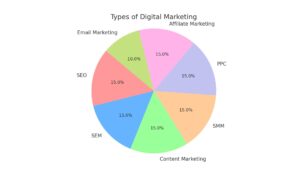Key Takeaways
| Aspect | Detail |
|---|---|
| Definition | Promotion of brands via digital channels |
| Importance | Accessible, cost-effective, and measurable |
| Key Types | SEO, SEM, Content Marketing, SMM, PPC, Affiliate Marketing, Email Marketing |
| B2B vs B2C | Different strategies for different target audiences |
| Measurement | Trackable and measurable impact |
Understanding Digital Marketing, a dynamic and ever-evolving field, stands as a cornerstone in the world of modern business and brand awareness. With the increasing dependence on digital platforms, digital marketing has become indispensable for businesses to connect with their audience effectively.
What is Digital Marketing?
At its core, digital marketing involves the promotion of brands and products through various digital channels like the internet, email, social media, and mobile apps. It’s a broad term encompassing different tactics and tools used to connect with customers online, where they spend a significant amount of time【9†source】【10†source】.
The Importance of Digital Marketing
Digital marketing has revolutionized how businesses interact with their audiences. Its importance can be attributed to several factors:
- Reach and Accessibility: The internet’s global reach allows businesses to connect with a wider audience more effectively than traditional marketing methods.
- Cost-Effectiveness: It offers a more affordable alternative to traditional marketing, with a lower barrier to entry.
- Measurability: Digital marketing provides measurable results, allowing businesses to track the effectiveness of their campaigns and adjust strategies accordingly.
Types of Digital Marketing
- Search Engine Optimization (SEO): Enhancing online content to improve visibility in search engine results.
- Search Engine Marketing (SEM): Paid advertising to increase search visibility.
- Content Marketing: Creating valuable content to attract and engage audiences.
- Social Media Marketing (SMM): Using social media platforms to connect with the audience.
- Pay-per-Click Advertising (PPC): Paid advertising where the advertiser pays per click on their ads.
- Affiliate Marketing: Earning commissions by promoting other company’s products.
- Email Marketing: Using email to promote products or services.
B2B vs B2C Digital Marketing
Digital marketing strategies differ significantly between B2B (Business to Business) and B2C (Business to Consumer) models:
- B2B Digital Marketing: Focuses on logical decision-making processes and longer sales funnels. It often involves relationship-building strategies.
- B2C Digital Marketing: Tends to be more emotional and instantaneous, targeting short-term offers and messages.
The Evolution of Digital Marketing
The history of digital marketing is as fascinating as it is diverse. The concept began over a century ago with the advent of radio, a form of digital marketing in its earliest form. Over the years, as technology advanced, so did the methods of digital marketing, expanding into the realms of television, phone marketing, and, more recently, the internet.
Online vs. Offline Digital Marketing
Digital marketing can be broadly categorized into online and offline marketing:
- Online Digital Marketing: Includes SEO, SEM, content marketing, SMM, PPC, affiliate marketing, and email marketing.
- Offline Digital Marketing: Encompasses enhanced offline marketing, radio, television, phone marketing, and the use of QR codes.
Implementing a Digital Marketing Strategy
To effectively implement a digital marketing strategy, businesses should:
- Identify Objectives: Clearly define what you want to achieve with your digital marketing efforts.
- Understand Your Audience: Know who your target audience is and tailor your marketing to their needs and preferences.
- Choose Appropriate Channels: Select the digital marketing channels that best suit your objectives and audience.
- Create Engaging Content: Develop content that resonates with your audience and encourages engagement.
- Measure and Adjust: Continuously track the performance of your campaigns and adjust your strategies for optimal results.
The Role of Technology in Digital Marketing
Technology plays a pivotal role in shaping and driving digital marketing strategies. The emergence of new technologies has continually transformed how businesses approach marketing. Key technological advancements impacting digital marketing include:
- Artificial Intelligence (AI): AI technologies, like machine learning and natural language processing, help in analyzing consumer behavior, optimizing advertising campaigns, and personalizing user experiences.
- Big Data Analytics: The use of big data helps businesses to understand market trends, customer preferences, and create targeted marketing strategies.
- Mobile Technology: With the increasing use of smartphones, mobile marketing has become crucial. This includes mobile-friendly websites, apps, and SMS marketing.
- Virtual Reality (VR) and Augmented Reality (AR): These technologies offer immersive experiences, making marketing campaigns more engaging and interactive.
Digital Marketing Challenges and Solutions
Despite its many advantages, digital marketing also presents several challenges:
- Data Privacy and Security: With the growing concerns over data privacy, businesses must ensure compliance with regulations like GDPR and maintain customer trust. Solution: Implementing robust data security measures and transparent data handling practices.
- Keeping Up with Technology: The rapid pace of technological change can be overwhelming. Solution: Continuous learning and adaptation are key. Businesses should stay informed about the latest trends and tools in digital marketing.
- High Competition: The accessibility of digital marketing means higher competition in virtually every niche. Solution: Differentiation through unique branding, high-quality content, and personalized customer experiences can help stand out.
- Adapting to Changing Algorithms: Search engines and social media platforms frequently update their algorithms, affecting visibility. Solution: Consistently create high-quality, relevant content and diversify digital marketing strategies to reduce reliance on a single platform.
The Future of Digital Marketing
The future of digital marketing is likely to be shaped by several emerging trends:
- Increased Personalization: Using AI and data analytics, businesses will offer more personalized and tailored content to their audience.
- Voice Search Optimization: With the rise of voice assistants, optimizing for voice search will become crucial.
- Interactive Content: More focus will be placed on interactive content like quizzes, polls, and AR/VR experiences to engage users.
- Influencer Marketing: Collaborating with influencers will continue to be a powerful marketing strategy, especially on social media platforms.
- Sustainability and Ethical Marketing: Consumers are increasingly valuing sustainability and ethical practices, which will become integral to marketing strategies.
Integrating Digital Marketing with Traditional Marketing
While digital marketing has taken the forefront, traditional marketing still holds value. The integration of digital and traditional marketing can offer a more comprehensive approach:
- Combining Online and Offline Data: Integrating data from both digital and traditional marketing campaigns can provide a fuller picture of customer behavior.
- Cross-Channel Marketing Campaigns: Creating campaigns that span both digital and traditional mediums can help reach a wider audience.
- Consistent Branding Across Channels: Maintaining a consistent brand message and aesthetic across all platforms enhances brand recognition.
Digital Marketing Best Practices
To maximize the effectiveness of digital marketing efforts, consider the following best practices:
- Focus on Customer Experience: Prioritize the customer experience in all digital marketing efforts, from website design to content creation.
- Utilize SEO Effectively: Continuously optimize content and websites for search engines to improve visibility.
- Engage in Social Listening: Monitor social media for customer feedback and trends to inform marketing strategies.
- Test and Optimize: Regularly test different aspects of digital marketing campaigns and use the data to optimize performance.
- Stay Agile: Be prepared to adapt strategies quickly in response to market changes or new trends.
The Role of Content Marketing in Digital Marketing
Content marketing is a critical component of digital marketing. It involves creating and sharing valuable content to attract and retain a clearly defined audience. The goal is to drive profitable customer action through content that educates, informs, entertains, or inspires.
- Types of Content: This includes blog posts, videos, infographics, podcasts, and more.
- Content Strategy: Developing a content strategy involves understanding the target audience, setting clear goals, and creating a content calendar.
Digital Marketing Analytics
Analytics in digital marketing is crucial for understanding campaign performance. Tools like Google Analytics provide insights into website traffic, user behavior, conversion rates, and more. These insights help in making data-driven decisions to improve marketing strategies.
Conclusion
Digital marketing, with its vast array of tools and techniques, offers businesses a powerful way to reach and engage with their audience in the digital age. By understanding its various facets and implementing effective strategies, businesses can achieve greater visibility, connect with their audience, and drive growth in an increasingly digital world.





